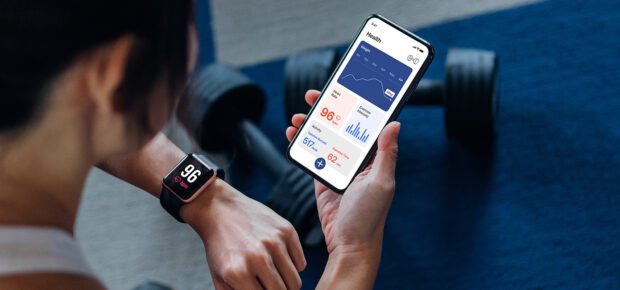June 8, 2022
Wearable devices collect a lot of information. But what happens to the information after it’s collected? It may not stay on the device at all, and that paves the way for a complex network of vulnerabilities of systems that expose data that many users would prefer remain confidential. .
Consider a fitness tracker. The device itself might collect data about where and how hard we worked out, but it’s usually stored on cloud-based services. Those services may integrate with applications that might also collect information about what we eat, how much we weigh,and the general state of our health. In addition, the apps themselves might also hold credit card information for payment purposes.
“By connecting a wearable to an extended ecosystem, one is exposing a larger attack surface,” said Aiyappan Pillai, IEEE Senior Member. “Cybersecurity experts look at this as a supply chain that includes a data generator, an analytics engine and a service provider. Each link in the chain, including the connecting networks, presents a potential risk.”
What’s the risk?
Most criminal intrusions of computer networks have a financial motive. That may lead people to conclude that wearables have a low cybersecurity risk. But wearables data, especially in healthcare settings, is often tied to financial information.
Depending on the organization from which it was obtained, stolen health data can be extremely valuable because it often includes so much personally identifiable information,including birthdays, email addresses and other login information- that can be used for identity theft purposes, said IEEE Senior Member Kevin Curran.
Hospitals, for example, might maintain extensive databases of personally identifiable information for billing purposes. And the rise of wearables, implants and other connected devices adds a new dimension to cybersecurity risk.
“Having such a large and diverse array of devices connected to the network will mean that there will be countless connected endpoints in each hospital. If proper visibility of the network is not achieved, then each endpoint will represent a potential vulnerability to try and exploit for cybercriminals,” Curran said
So what should consumers look for in a device?
Curran said consumers should try to buy wearable devices from reputable manufacturers.
“The key security weakness of wearable devices can be their lack of security updates,” Curran said. “There is no legal requirement for wearable manufacturers to provide a roadmap of security updates for a specified period. However the larger the manufacturers are, the more likely they are to provide patches in the future.”
App designers need to also ensure user-friendliness while incorporating security measures that cater to all categories of users, including older patients that may not have familiarity with newer technology.
Some security features that consumers should look for include “strong multi-factor authentication methods for device access, which may be biometric, such as fingerprint voice recognition, iris recognition, passwords and location-based authentication.”
For makers of wearables, building secure products will be key to success as security challenges grow.
“Security issues will consume even more resources by overhead data and processing,”said IEEE Senior Member Vicente Ferreira de Lucena Jr., “We need more efficient procedures, without losing their reliability.”IEEE members and volunteers provide crucial guidance on ways that companies can build secure apps and devices. In this podcast, learn more about privacy and security challenges in the management of wearables and connected medical devices.





 Meaningful Momentum or Running in Place?
Meaningful Momentum or Running in Place? AI Through Our Ages
AI Through Our Ages Liquid Infrastructure: Our Planet's Most Precious Resource
Liquid Infrastructure: Our Planet's Most Precious Resource The Impact of Technology in 2025
The Impact of Technology in 2025 Quantum and AI: Safeguards or Threats to Cybersecurity?
Quantum and AI: Safeguards or Threats to Cybersecurity? Why AI Can't Live Without Us
Why AI Can't Live Without Us Bits, Bytes, Buildings and Bridges: Digital-Driven Infrastructure
Bits, Bytes, Buildings and Bridges: Digital-Driven Infrastructure Impact of Technology in 2024
Impact of Technology in 2024 Emerging AI Cybersecurity Challenges and Solutions
Emerging AI Cybersecurity Challenges and Solutions The Skies are Unlimited
The Skies are Unlimited Smart Cities 2030: How Tech is Reshaping Urbanscapes
Smart Cities 2030: How Tech is Reshaping Urbanscapes Impact of Technology 2023
Impact of Technology 2023 Cybersecurity for Life-Changing Innovations
Cybersecurity for Life-Changing Innovations Smarter Wearables Healthier Life
Smarter Wearables Healthier Life Infrastructure In Motion
Infrastructure In Motion The Impact of Tech in 2022 and Beyond
The Impact of Tech in 2022 and Beyond Cybersecurity, Technology and Protecting Our World
Cybersecurity, Technology and Protecting Our World How Technology Helps us Understand Our Health and Wellness
How Technology Helps us Understand Our Health and Wellness The Resilience of Humanity
The Resilience of Humanity Harnessing and Sustaining our Natural Resources
Harnessing and Sustaining our Natural Resources Creating Healthy Spaces Through Technology
Creating Healthy Spaces Through Technology Exceptional Infrastructure Challenges, Technology and Humanity
Exceptional Infrastructure Challenges, Technology and Humanity The Global Impact of IEEE's 802 Standards
The Global Impact of IEEE's 802 Standards Scenes of our Cyber Lives: The Security Threats and Technology Solutions Protecting Us
Scenes of our Cyber Lives: The Security Threats and Technology Solutions Protecting Us How Millennial Parents are Embracing Health and Wellness Technologies for Their Generation Alpha Kids
How Millennial Parents are Embracing Health and Wellness Technologies for Their Generation Alpha Kids Space Exploration, Technology and Our Lives
Space Exploration, Technology and Our Lives Global Innovation and the Environment
Global Innovation and the Environment How Technology, Privacy and Security are Changing Each Other (And Us)
How Technology, Privacy and Security are Changing Each Other (And Us) Find us in booth 31506, LVCC South Hall 3 and experience the Technology Moon Walk
Find us in booth 31506, LVCC South Hall 3 and experience the Technology Moon Walk Virtual and Mixed Reality
Virtual and Mixed Reality How Robots are Improving our Health
How Robots are Improving our Health IEEE Experts and the Robots They are Teaching
IEEE Experts and the Robots They are Teaching See how millennial parents around the world see AI impacting the lives of their tech-infused offspring
See how millennial parents around the world see AI impacting the lives of their tech-infused offspring Take the journey from farm to table and learn how IoT will help us reach the rising demand for food production
Take the journey from farm to table and learn how IoT will help us reach the rising demand for food production Watch technical experts discuss the latest cyber threats
Watch technical experts discuss the latest cyber threats Explore how researchers, teachers, explorers, healthcare and medical professionals use immersive technologies
Explore how researchers, teachers, explorers, healthcare and medical professionals use immersive technologies Follow the timeline to see how Generation AI will be impacted by technology
Follow the timeline to see how Generation AI will be impacted by technology Learn how your IoT data can be used by experiencing a day in a connected life
Learn how your IoT data can be used by experiencing a day in a connected life Listen to technical experts discuss the biggest security threats today
Listen to technical experts discuss the biggest security threats today See how tech has influenced and evolved with the Games
See how tech has influenced and evolved with the Games Enter our virtual home to explore the IoT (Internet of Things) technologies
Enter our virtual home to explore the IoT (Internet of Things) technologies Explore an interactive map showcasing exciting innovations in robotics
Explore an interactive map showcasing exciting innovations in robotics Interactively explore A.I. in recent Hollywood movies
Interactively explore A.I. in recent Hollywood movies Get immersed in technologies that will improve patients' lives
Get immersed in technologies that will improve patients' lives